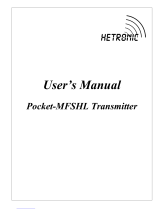
4 Table of Contents WAGO-I/O-SYSTEM 750
750-377 PROFINET IO advanced ECO Fieldbus Coupler
Manual
Version 1.3.1
4 Device Description ................................................................................... 50
4.1 Fieldbus Coupler Properties .................................................................. 51
4.1.1 General Specifications ...................................................................... 51
4.1.2 PROFINET IO Properties .................................................................. 51
4.1.3 Implemented Protocols and Services ................................................ 52
4.1.4 Supported Profiles for PROFINET IO ................................................ 53
4.2 View ....................................................................................................... 54
4.3 Connectors ............................................................................................. 56
4.3.1 Device Supply ................................................................................... 56
4.3.2 Fieldbus Connection.......................................................................... 57
4.4 Display Elements ................................................................................... 58
4.5 Operating Elements ............................................................................... 60
4.5.1 Service Interface ............................................................................... 60
4.5.2 DIP Switch ......................................................................................... 61
4.6 Technical Data ....................................................................................... 64
4.6.1 Device Data ....................................................................................... 64
4.6.2 System Data ...................................................................................... 65
4.6.3 Supply ............................................................................................... 65
4.6.4 Accessories ....................................................................................... 66
4.6.5 Connection Type ............................................................................... 66
4.6.6 Climatic Environmental Conditions .................................................... 67
4.7 Approvals ............................................................................................... 68
4.8 Standards and Guidelines ...................................................................... 69
5 Mounting ................................................................................................... 70
5.1 Installation Position ................................................................................ 70
5.2 Overall Configuration ............................................................................. 71
5.3 Mounting onto Carrier Rail ..................................................................... 72
5.3.1 Carrier Rail Properties ....................................................................... 72
5.3.2 WAGO DIN Rails ............................................................................... 73
5.4 Spacing .................................................................................................. 73
5.5 Mounting Sequence ............................................................................... 74
5.6 Inserting and Removing Devices ........................................................... 75
5.6.1 Inserting the Fieldbus Coupler/Controller .......................................... 76
5.6.2 Removing the Fieldbus Coupler/Controller ....................................... 77
5.6.3 Inserting the I/O Module .................................................................... 78
5.6.4 Removing the I/O Module.................................................................. 79
6 Connect Devices ....................................................................................... 80
6.1 Data Contacts/Local Bus ....................................................................... 80
6.2 Power Contacts/Field Supply ................................................................. 81
6.3 Connecting a Conductor to the CAGE CLAMP
®
.................................... 82
7
Function Description ................................................................................ 83
7.1 Device Start-Up and Initialization ........................................................... 83
7.2 Switch Port Settings ............................................................................... 84
7.3 Identification and Maintenance Data Sets (I&M) .................................... 85
7.4 Process Data Architecture ..................................................................... 86
7.4.1 Basic Structure .................................................................................. 86
7.4.1.1 Allocation of the Input and Output Data ........................................ 87
7.4.2 Process Data Qualifiers in Telegrams for PROFINET IO .................. 88





















